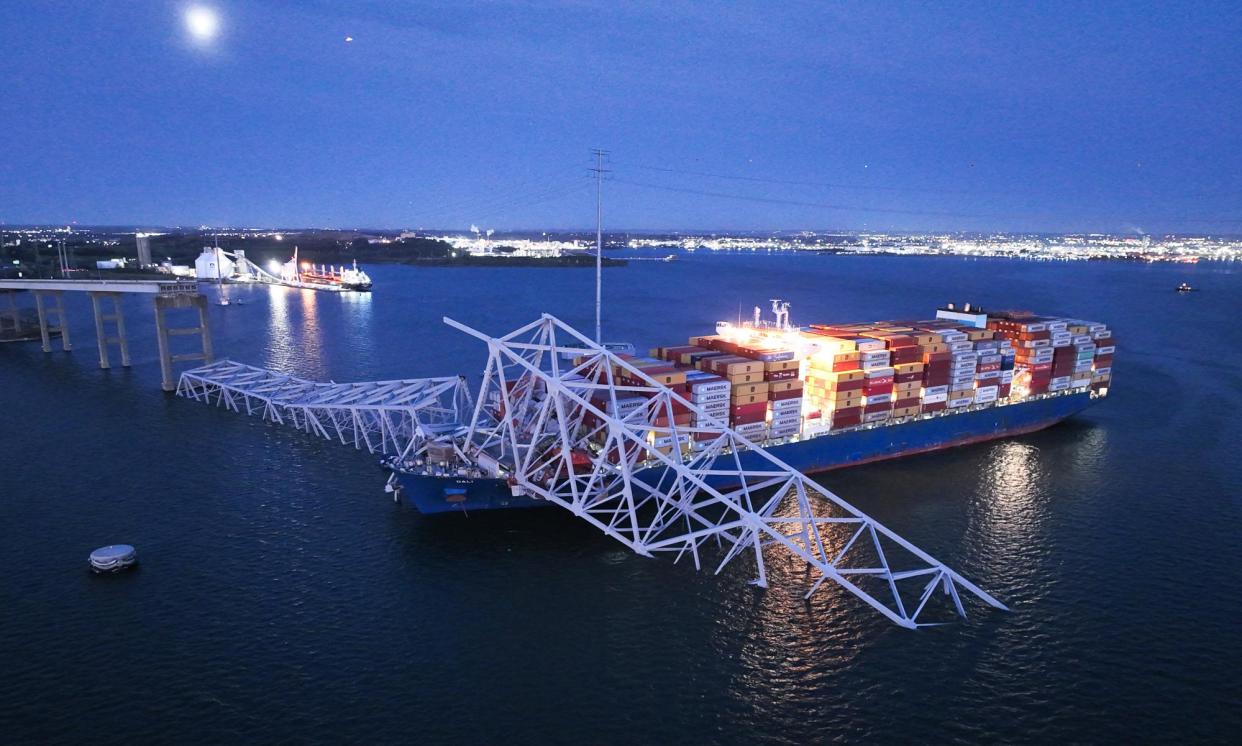Baltimore bridge was ‘up to code’ – but rules predate age of supersized ships

The collapse of the Francis Scott Key Bridge in Baltimore has revived scrutiny not just of this specific structure but also the overall health of bridges across the US, many of which are considered to be in poor condition.
Related: Baltimore bridge collapse: what we know about the bridge, ship and port
It’s so far unclear whether the downfall of the bridge, which was hit by a large container ship and crumpled into the Patapsco River early on Tuesday morning, was down to any fault in the structure itself.
Officials have said the ship issued a mayday as it went off course and seemed to lose power.
The National Transportation Safety Board is dispatching a team to investigate the disastrous collapse, which has left six people still unaccounted for. Wes Moore, Maryland’s governor, has said the bridge was “fully up to code”, while some experts have pointed out that the span, completed in 1977, was conceived before an age of supersized container ships.
Andrew Barr, an expert in civil and structural engineering at the University of Sheffield, said that “the video doesn’t show any obvious structural deficiencies with the bridge, but it will not have been designed to survive a head-on collision with such a large vessel”.
Barr added that the Francis Scott Key Bridge did not appear to have additional protective infrastructure to buffer it from ship strikes, which have become more risky as the size and design of cargo vessels has changed over the years. In the last decade alone, the average capacity of container ships has increased by about 50%.
But the spectacular collapse has again highlighted concerns about the overall state of US bridges, with more than a third of them in need of repair, according to the American Road & Transportation Builders Association. The state of US bridges has slowly improved in recent years, the association said, but more than 43,000 are still considered to be in poor condition and classed as “structurally deficient”, risking potential collapse in the future.
“This disaster reveals how exposed America’s critical infrastructure is to sudden and devastating accidents as well as intentional destruction,” said Rick Geddes, infrastructure policy expert and director of the Cornell University infrastructure policy program.
“Improved resilience should be on everyone’s mind as aging infrastructure is rebuilt. Enhanced protection against ship-bridge collisions will certainly become more salient.”
Geddes said the Baltimore disaster should be viewed as an “opportunity to rebuild American infrastructure in a smart way, which includes new materials and designs to reduce the risk of future accidents, including sensors embedded in the bridge that communicate in real time with approaching ships”.
The parlous state of American bridges was singled out by the Biden administration as a motivator for the $1.2tn bipartisan infrastructure law signed by the US president in 2021. The bill includes $110bn to upgrade roads and bridges, with Biden recently visiting a deteriorating bridge in Wisconsin to tout its repair via the funding.
“For decades, people talked about replacing this bridge, but it never got done. Until today,” Biden said at January event. “This bridge is important, but the story we’re writing is much bigger than that.”
A certain amount of risk will remain for the foreseeable future, however – each day around 167m trips are taken across structurally deficient bridges in the US.
As for Baltimore’s Francis Scott Key Bridge, Biden said on Tuesday that it is his intention that the federal government should pay the full cost of replacing it, and called on Congress for its support.


